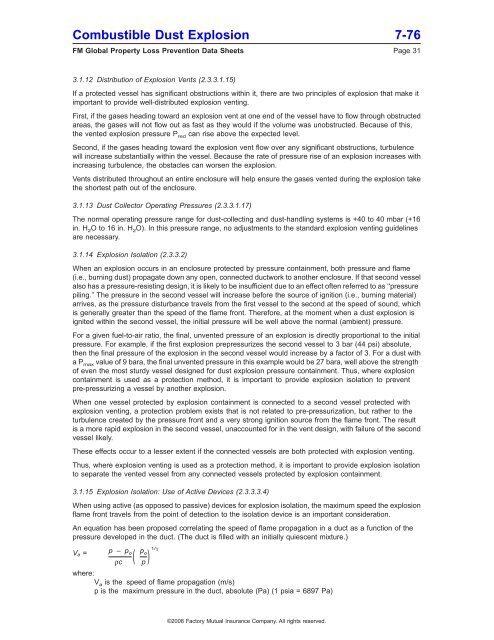DS 7-76 Prevention and Mitigation of Combustible Dust ... - FM Global
DS 7-76 Prevention and Mitigation of Combustible Dust ... - FM Global
DS 7-76 Prevention and Mitigation of Combustible Dust ... - FM Global
Create successful ePaper yourself
Turn your PDF publications into a flip-book with our unique Google optimized e-Paper software.
<strong>Combustible</strong> <strong>Dust</strong> Explosion 7-<strong>76</strong><br />
<strong>FM</strong> <strong>Global</strong> Property Loss <strong>Prevention</strong> Data Sheets Page 31<br />
3.1.12 Distribution <strong>of</strong> Explosion Vents (2.3.3.1.15)<br />
If a protected vessel has significant obstructions within it, there are two principles <strong>of</strong> explosion that make it<br />
important to provide well-distributed explosion venting.<br />
First, if the gases heading toward an explosion vent at one end <strong>of</strong> the vessel have to flow through obstructed<br />
areas, the gases will not flow out as fast as they would if the volume was unobstructed. Because <strong>of</strong> this,<br />
the vented explosion pressure P red can rise above the expected level.<br />
Second, if the gases heading toward the explosion vent flow over any significant obstructions, turbulence<br />
will increase substantially within the vessel. Because the rate <strong>of</strong> pressure rise <strong>of</strong> an explosion increases with<br />
increasing turbulence, the obstacles can worsen the explosion.<br />
Vents distributed throughout an entire enclosure will help ensure the gases vented during the explosion take<br />
the shortest path out <strong>of</strong> the enclosure.<br />
3.1.13 <strong>Dust</strong> Collector Operating Pressures (2.3.3.1.17)<br />
The normal operating pressure range for dust-collecting <strong>and</strong> dust-h<strong>and</strong>ling systems is +40 to 40 mbar (+16<br />
in. H 2O to 16 in. H 2O). In this pressure range, no adjustments to the st<strong>and</strong>ard explosion venting guidelines<br />
are necessary.<br />
3.1.14 Explosion Isolation (2.3.3.2)<br />
When an explosion occurs in an enclosure protected by pressure containment, both pressure <strong>and</strong> flame<br />
(i.e., burning dust) propagate down any open, connected ductwork to another enclosure. If that second vessel<br />
also has a pressure-resisting design, it is likely to be insufficient due to an effect <strong>of</strong>ten referred to as ‘‘pressure<br />
piling.’’ The pressure in the second vessel will increase before the source <strong>of</strong> ignition (i.e., burning material)<br />
arrives, as the pressure disturbance travels from the first vessel to the second at the speed <strong>of</strong> sound, which<br />
is generally greater than the speed <strong>of</strong> the flame front. Therefore, at the moment when a dust explosion is<br />
ignited within the second vessel, the initial pressure will be well above the normal (ambient) pressure.<br />
For a given fuel-to-air ratio, the final, unvented pressure <strong>of</strong> an explosion is directly proportional to the initial<br />
pressure. For example, if the first explosion prepressurizes the second vessel to 3 bar (44 psi) absolute,<br />
then the final pressure <strong>of</strong> the explosion in the second vessel would increase by a factor <strong>of</strong> 3. For a dust with<br />
a P max value <strong>of</strong> 9 bara, the final unvented pressure in this example would be 27 bara, well above the strength<br />
<strong>of</strong> even the most sturdy vessel designed for dust explosion pressure containment. Thus, where explosion<br />
containment is used as a protection method, it is important to provide explosion isolation to prevent<br />
pre-pressurizing a vessel by another explosion.<br />
When one vessel protected by explosion containment is connected to a second vessel protected with<br />
explosion venting, a protection problem exists that is not related to pre-pressurization, but rather to the<br />
turbulence created by the pressure front <strong>and</strong> a very strong ignition source from the flame front. The result<br />
is a more rapid explosion in the second vessel, unaccounted for in the vent design, with failure <strong>of</strong> the second<br />
vessel likely.<br />
These effects occur to a lesser extent if the connected vessels are both protected with explosion venting.<br />
Thus, where explosion venting is used as a protection method, it is important to provide explosion isolation<br />
to separate the vented vessel from any connected vessels protected by explosion containment.<br />
3.1.15 Explosion Isolation: Use <strong>of</strong> Active Devices (2.3.3.3.4)<br />
When using active (as opposed to passive) devices for explosion isolation, the maximum speed the explosion<br />
flame front travels from the point <strong>of</strong> detection to the isolation device is an important consideration.<br />
An equation has been proposed correlating the speed <strong>of</strong> flame propagation in a duct as a function <strong>of</strong> the<br />
pressure developed in the duct. (The duct is filled with an initially quiescent mixture.)<br />
( )<br />
Va = p – po po ρc p<br />
1/γ<br />
where:<br />
V a is the speed <strong>of</strong> flame propagation (m/s)<br />
p is the maximum pressure in the duct, absolute (Pa) (1 psia = 6897 Pa)<br />
©2008 Factory Mutual Insurance Company. All rights reserved.

















